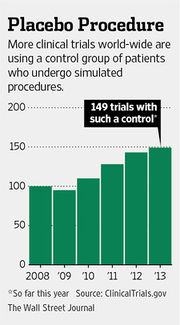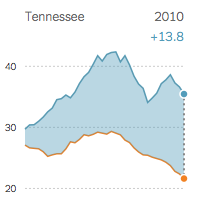Chance News 97
Quotations
I beseech you, in the bowels of Christ, think it possible that you may be mistaken. --Oliver Cromwell
Cromwell's rule, named by statistician Dennis Lindley, states that the use of prior probabilities of 0 or 1 should be avoided, except when applied to statements that are logically true or false. For instance, Lindley would allow us to say that Pr(2+2 = 4) = 1, where Pr represents the probability. In other words, arithmetically, the number 2 added to the number 2 will certainly equal 4.
Submitted by Paul Alper
"[Choosing] what to do in the face of uncertainty is never a scientific question. The science is elucidating the possibilities and the probabilities but how to act and how to react is your own values. And we always have to make that explicit. But if you don’t have any information, it’s hard to know how to apply your values in more than a random way."
Dot Earth blog, New York Times, 20 December, 2013
Submitted by Bill Peterson
"When you find common errors in the scientific literature – such as a simple misinterpretation of p values – hit the perpetrator over the head with your statistics textbook. It’s therapeutic."
Submitted by Paul Alper
“Uncertainty is an uncomfortable position. But certainty is an absurd one."
"I call myself a Possibilian: I'm open to...ideas that we don't have any way of testing right now."
"Possibilism (philosophy), the metaphysical belief that possible things exist"
Submitted by Margaret Cibes
Forsooth
“The difference in mortality rates [in deaths per 100,000 women] between black women [top curve] and white women [bottom curve] with breast cancer has widened since 1975, in part because black women have not benefited as much from improvements in screening and treatment. Among the states with available data, Tennessee has the largest gap—with nearly 14 black women dying for every one white woman.”
The phrase in bold appeared in the printed National Edition (p. A22) but was removed without comment from the online version by Dec. 24. None of the 162 online comments on the accompanying article questioned the phrase.
Submitted by Paul Campbell
"Environment Canada is predicting the vast majority of the country will see below-normal temperatures — and snowfall — through March. In Thunder Bay and the Northwest, the probability of this is seen as between 50 and 60 per cent. Which means the weather office could be only half-right."
Submitted by Bill Peterson
Sham knee surgery study
Common knee surgery does very little for some, study suggests
by Pam Belluck, New York Times, 25 December 2013
The article concerns an arthroscopic procedure to repair a torn meniscus--the cartilage in the knee. According to the article, about 700,000 such surgeries are performed annually, the most for any orthopedic procedure. But is the procedure actually effective? That is the question considered by a study conducted in Finland involving 146 patients at five hospitals. All of the subjects underwent arthroscopic procedures which involved making an incision and inserting a scope to assess the injury. However, at this point, it was randomly determined whether the meniscus would actually be trimmed or if a false blade would be rubbed on the knee cap as a sham treatment. The subjects did not know which treatment they got. In follow-up interviews a year later, comparable proportions of each reported that the procedure had improved their condition, and said that they would have it again, even though it might be a sham treatment.
The following quotation comes from a related story in the Wall Street Journal:
- "Doctors have a bad tendency to confuse what they believe with what they know," said Dr. Järvinen [one of the study's authors], an orthopedic resident and adjunct professor at Helsinki University Central Hospital.
The WSJ article also included the following graphic, which documents the increasing use of sham surgery as a control.

Submitted by Paul Alper
The Distributome Project
The Distributome Project is a collection of web-based resources for teachers and students of probability, statistics, and partner disciplines.
The heart of Distributome is a digital library of special, parametric probability distributions. Properties of distributions, and relations between distributions, are stored in an XML database. Properties of a distribution include density, distribution, quantile, and generating functions; various moments, such as mean, variance, skewness, kurtosis, and entropy; median and other special quantiles; and so forth. Relations between distributions are classified in various standard ways, such as special cases, transformations on underlying random variables, limits of random variables or parameters, and conditioning.
Built from the database are a number of innovative features and ancillary resources:
- The Navigator is a dynamic, graphical interface in which the distributions are represented as nodes and the relations as edges between nodes. Clicking on a node shows the properties of the distribution, while clicking on an edge shows the relationship between the corresponding distributions.
- Interactive simulators and calculators are available for most common distributions. A simulator illustrates a distributions in a visual and dynamic way, often with the help of randomizing devices (such as coins or balls) or an underlying random process. A calculator can be used to compute values of the distribution function or quantile function.
- The Distributome Blog is a collection of activities that use probability distributions to model and solve problems in a variety of applied areas, often with real and historically interesting data sets. Each activity includes an overview, goals and problems, and hints and solutions. For example, the Homicide Trends Activity explores fitting a Poisson distribution to homicide data, based on a news story from the Columbus Dispatch.
- The Distributome Game challenges students to identify the correct probability distribution for a given problem statement. The game is timed, and is in the form of an array, with problems statements in the rows and distributions in the columns. Various settings are available to custom the game.
The Distributome project is freely available, open-source, and is built on standard web technologies. It is supported through grants from the National Science Foundation (grants 1023115, 1022560, and 1022636).
Submitted by Kyle Siegrist
Some CT averages
CT's 2013 assessment documents describe the calculations behind some of its figures, calculations that might provoke some interesting class discussions. (Email CibesM@comcast.net for a more detailed account, with references.)
Our Mastery Tests are administered to all public school students in grades 3-8 in three subjects (Mathematics, Reading, Writing) and to students in grades 5 and 8 in one additional subject (Science). For the sake of simplicity, and contrary to fact, assume that all grade 3-8 students take the same standard test forms, and that they do not have any "invalid" or "excluded" test scores. (The "GPA" label is mine, not the State Department of Education's.)
Individual student test score. Based on a student's individual test score in a single subject, the student's performance is assigned to one of five qualitative categories – Advanced, Goal, Proficient, Basic, or Below Basic. Each category is then translated into one of four index scores – Advanced/Goal (=100), Proficient (=67), Basic (=33), and Below Basic (=0). Note that Goal is 88.
Individual student "GPA." A student's index scores in the three/four required subjects are averaged to create a Student IPI (Individual Performance Index).
.
School "GPA." All of a school's Student IPIs are averaged over all subjects and all grades to create an SPI (School Performance Index). Note that this average of averages aggregates the IPIs of students at different grade levels, not all of whom took Science tests. Also, the SPI is modified by wrapping it into a school classification system – Excelling, Progressing, Transitioning, Review, and Turnaround – depending upon the SPI plus other factors that are said not to apply uniformly to all schools.
District "GPA." All of a district's Student IPIs are averaged over all subjects in all six grades to create a DPI (District Performance Index).
Discussion
A stated goal of CT's assessment process is to identify areas of strength/weakness in CT's students/schools/districts, for the ultimate purpose, one would imagine, of improving teaching/learning in subject areas.
1. Which, if any, of these figures might help school systems improve teaching/learning in a subject area? Why or why not?
2. What purpose, other than possibly ranking, might the IPI/SPI/DPI serve?
3. In what way(s) is the initial index-scoring procedure questionable?
4. All of the averages are arithmetic means. Identify some potentially negative consequences of these averages and these averages of averages.
Submitted by Margaret Cibes
